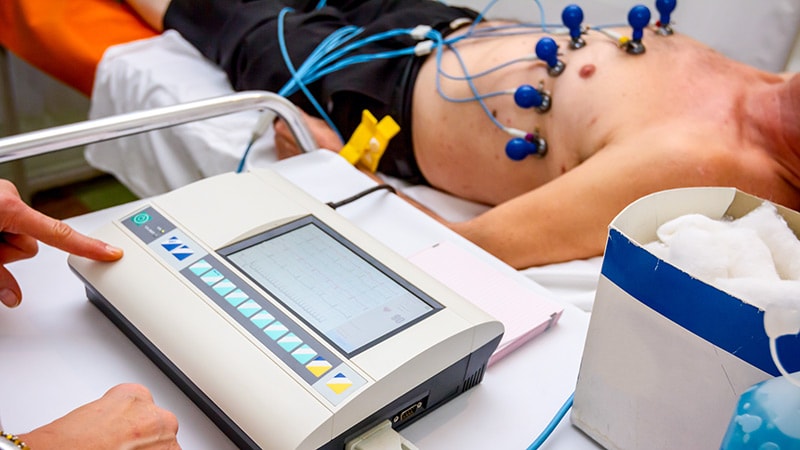It’s common for patients to schedule an office visit due to symptoms like shortness of breath from doing regular tasks, feeling heart palpitations, experiencing mild chest pain, or feeling weak or unusually tired.
During your assessment, if you determine that the patient has an irregular heartbeat, a family history of cardiac conditions, or believe further testing is warranted, realize that a patient could be fearful of cardiac testing. To ease the concerns of your patients, it’s important to explain how such testing can diagnose the reason they aren’t feeling quite right and how their treatment team can help them feel better.
Start With the Why
Leaving the trusted environment of a primary care office can be daunting for patients, particularly for those who haven’t had cardiac testing before. But explaining why you’re suggesting the tests can help a patient understand.
“The most important step would be to explain how cardiac testing can be important in order to screen for issues before they become serious,” said David Weininger Cohen, MD, a cardiologist with the Leonard M. Miller School of Medicine at the University of Miami in Florida.
He also suggested recounting what symptoms patients are experiencing and how specific tests can investigate what’s causing them. Also, explaining that some symptoms may not even be tied to cardiac issues could be another strategy to demonstrate the importance of further testing.
“For instance, chest pain is a symptom that becomes a common reason for visits. Most people usually associate chest pain with heart issues, but there are a lot of structures in the chest that can cause pain, not just the heart — cartilage, esophagus, sometimes part of the stomach, skin, and even nerve endings,” he said. “Ultimately, cardiac testing is important because it allows the physician to discriminate between cardiac and non-cardiac causes for the patient’s symptoms.”
In addition, reassuring your patients that these experts can diagnose potential issues may also ease their worries, so articulate how such cardiac tests are performed in a controlled environment with trained staff that can anticipate issues and respond quickly if something goes wrong, Weininger Cohen added.
Understand Patients Are Fearful of Test Results
Some patients are afraid of the results as much as the test.
“In those cases, I like to reinforce why the test is necessary and why we’re doing it,” said Weininger Cohen. “Additionally, I sometimes go through the possible scenarios depending on the results of each test.” Knowing what lies ahead, depending on what the test shows, can sometimes be reassuring — you’re showing patients you know exactly what the next steps would be.
Treat Fears Patient by Patient
Although there are some general practice strategies to ease fear regarding cardiac testing, personalizing your approach is also important.
“The best way to tackle fear of cardiac testing would be to ask the patient exactly what they’re afraid of,” said Weininger Cohen. Some patients are going to be afraid of having pain or discomfort during the test. Some patients are afraid of what the results may be, and some patients are afraid of possible complications.
“Usually, the best way to approach the topic is to explain the reason for the test and then address the specific fear the patient has,” he specified.
For example, the best way to describe an EKG would be to explain that it is a test that is trying to capture the electrical activity of the heart. To achieve that, the person performing it is putting sensors on different parts of the patient’s body to detect the heart’s electrical current from different points, he said. Emphasizing that the test is painless, and that it’s just capturing the natural electrical activity of the heart, should put patients at ease.
How Can You Best Describe an Echocardiogram?
Most patients understand what an ultrasound is, so advising patients that an echocardiogram is simply an ultrasound study of the heart can calm fears. It may also be helpful to share that in some cases, ultrasounds use enhancing agents, referred to as contrast, to get a look at the different structures of the heart, he said.
Some patients could be concerned about radiation.
“Both tests are radiation free, and this is something that some patients are very interested in knowing before proceeding, especially if they have been previously exposed to radiation through other diagnostic imaging tests or radiotherapy for cancer treatment,” Weininger Cohen said. Taking the time to explain both an echocardiogram and an EKG can help your patients understand what to expect and reduce worry and the fear of the unknown.
What to Tell Patients Before Referring to a Cardiologist
Referring a patient to a specialist like a cardiologist could cause fear. So explain why you’re taking this step.
“Telling a patient why they need to see a heart expert and how they will add to their overall care can be a helpful first step,” said Mustafa M. Ahmed, MD, a cardiologist and professor of medicine, who’s also vice chief of research of the Division of Cardiovascular Medicine and medical director of the Mechanical Circulatory Support Program at the University of Florida in Gainesville. “Assuring them that they won’t be losing their primary care doctor, but gaining a specialist to consult with both them and the primary care team, is often a good way to frame expectations.”
Lifestyle Tweaks You Might Suggest
In the context of your discussions with patients regarding their symptoms and recommendations for cardiac testing, Ahmed suggested expressing how diet and exercise, as a part of overall lifestyle changes, can be the most impactful way to prevent heart disease.
“Gentle guidance and step-by-step encouragement are often helpful,” he said.
Also, involving other family members and friends in that journey is another strategy. This may include taking walks, preparing meals together, or embracing a healthier mindset overall.
